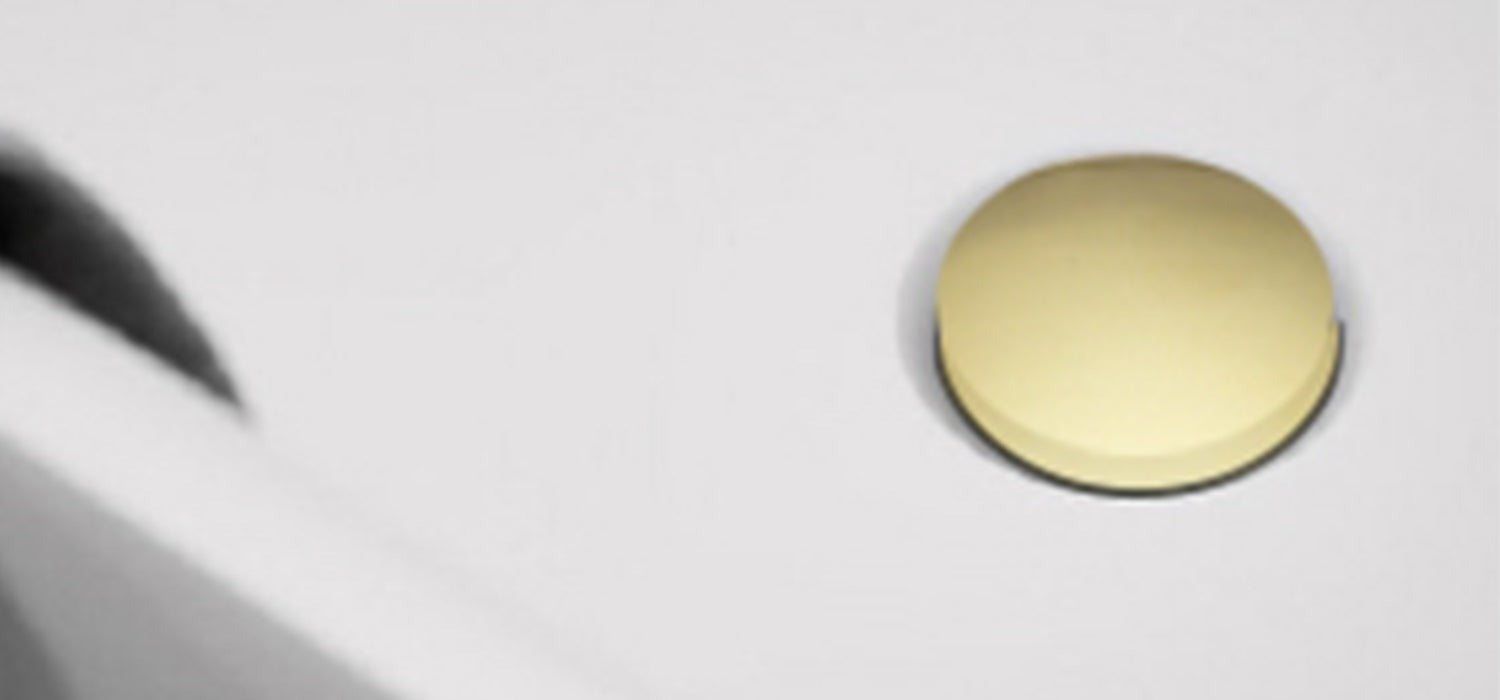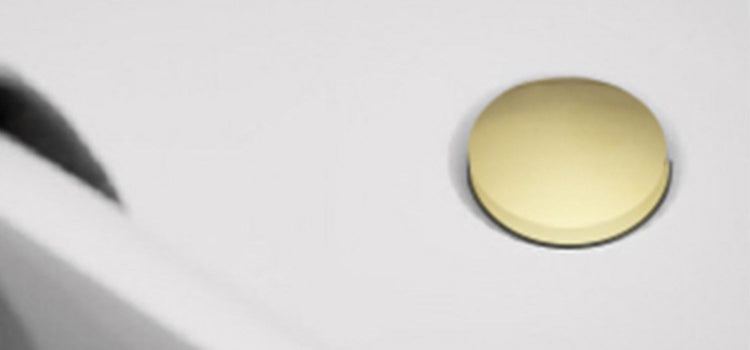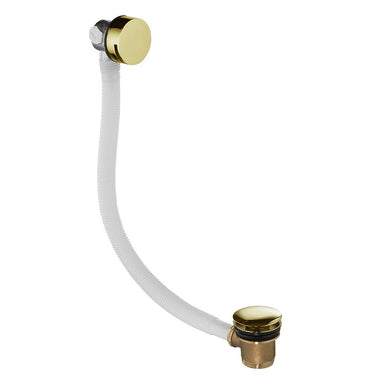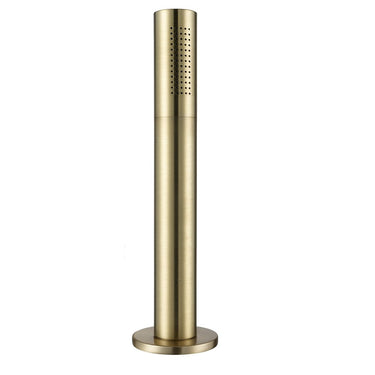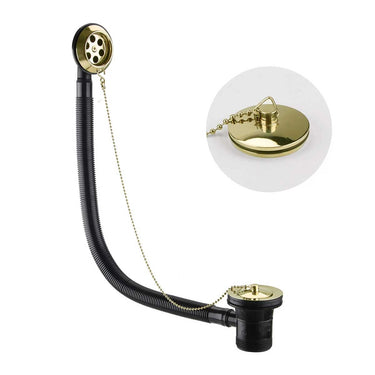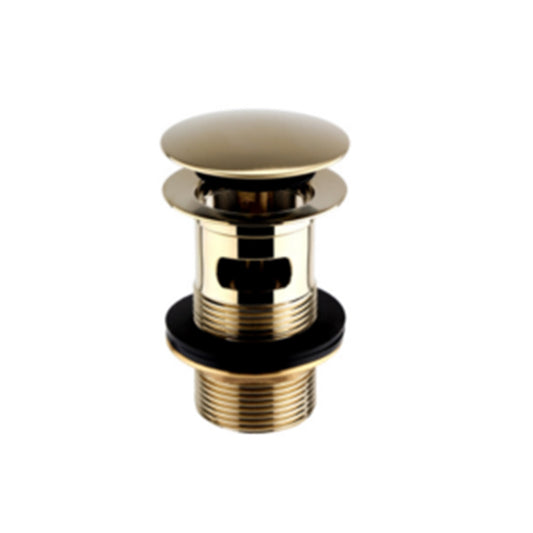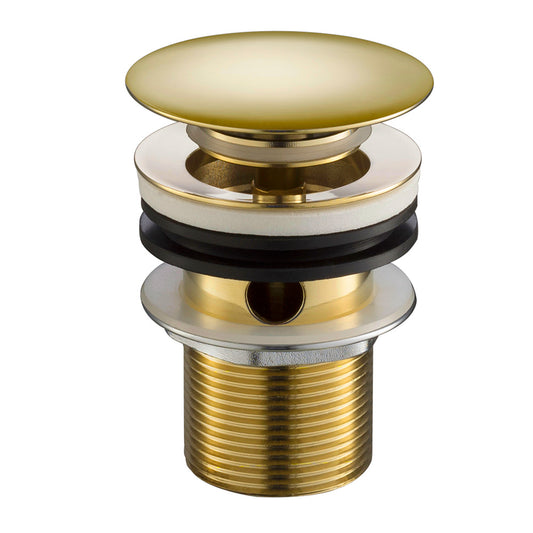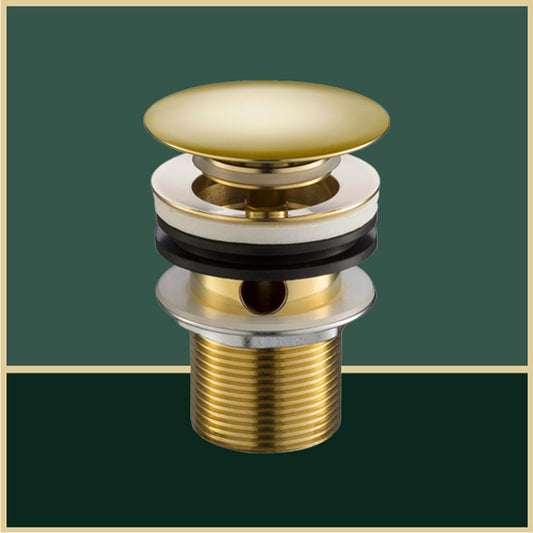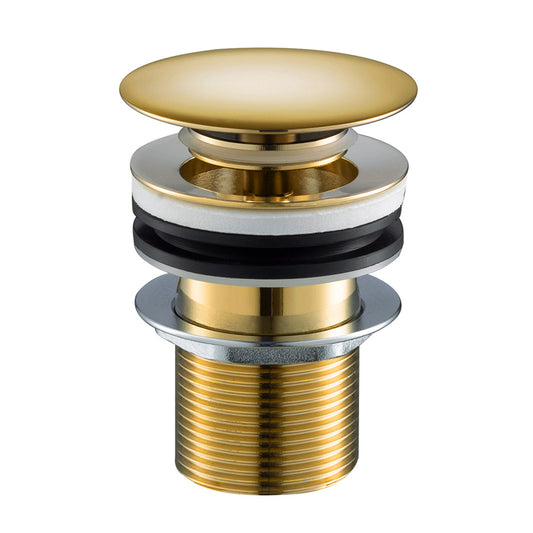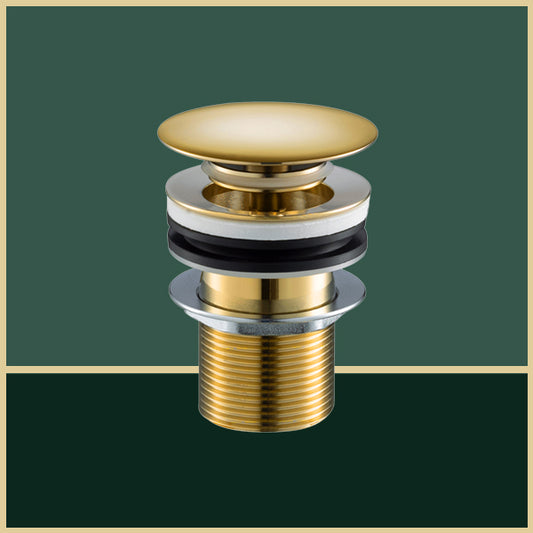The Complete Guide to Bath Wastes: Functionality, Style, and Selection
Table Of Contents:
-
Introduction
-
What is Bath Waste?
-
How Does a Bath Waste Work?
-
Different Types of Bath Wastes and Their Features
-
Choosing the Right Bath Waste for Your Bathroom
-
Pricing Guide for Bath Wastes in the UK
-
Step-by-Step Guide to Installing a Bath Waste System
-
Maintenance of Bath Wastes: Keeping Your System in Top Condition
-
How to Measure and Choose the Right Size for Your Bath Waste
-
Bath Waste Systems for Bathtubs: Choosing the Right Fit
-
Conclusion
-
FAQs
Introduction
A bath waste is an essential component of any bathtub, responsible for draining the water once you're finished with your bath. It consists of various parts, including the drain, waste fitting, overflow, and often a plug or waste control mechanism. Understanding how bath wastes work, the types available, and how to maintain them will help you make the right choice when installing or replacing one in your bathroom.
What is Bath Waste?
A bath waste is the drainage system in a bathtub that allows water to flow out of the tub and into the home's plumbing system. It consists of several key components that ensure proper drainage and prevent overflow. The main parts of a bath waste typically include:
-
Drain: This is the opening at the bottom of the bathtub where water exits. It connects to the plumbing system to direct water to the sewer or drainage system.
-
Waste Fitting: The waste fitting is the part that attaches the drain to the plumbing pipes beneath the tub. It channels the water away from the bathtub and into the pipes.
-
Overflow: A safety feature that diverts excess water from the tub into the drain if the water level gets too high, preventing water from spilling over the sides of the tub. The overflow is typically located on the side of the bathtub and connects to the waste fitting.
-
Waste Control Mechanism: This is the system used to control the flow of water in and out of the tub. It can be a plug and chain, push-button, click-clack, or pop-up waste system, depending on the style and design of the bathtub. This mechanism allows you to seal the drain to fill the tub with water or open it to drain the water once you're finished.
A bath waste system is crucial for proper tub drainage, ensuring that water flows out safely and efficiently without causing leaks or overflows.

How Does a Bath Waste Work?
A bath waste works by controlling the flow of water in and out of the bathtub through a series of interconnected components, including the drain, waste fitting, overflow, and waste control mechanism. Here's a step-by-step guide on how a typical bath waste system functions:
1. Filling the Bathtub
When you fill your bathtub with water, it begins to rise within the tub. The waste control mechanism (whether it’s a plug-and-chain, push-button, or click-clack system) remains closed, keeping the water inside the tub. If the bathtub is equipped with an overflow, it ensures that excess water doesn’t spill over the sides.
2. Overflow Mechanism (If Present)
Most bathtubs feature an overflow hole, usually located at the top of the bathtub, near the rim. If the water level in the tub gets too high, the overflow allows excess water to flow into a drain pipe that’s connected to the main waste fitting. This prevents the tub from overflowing and spilling water onto the bathroom floor.
3. Draining the Water
Once you’re finished using the bath, you can open the drain to release the water. If the waste system has a plug-and-chain or push-button, you manually or by pressing the button open the drain to let the water out.
In a click-clack system, a simple press on the waste mechanism opens the drain and starts the water draining. The water flows down the waste fitting and is carried through the plumbing pipes beneath the tub to the home's drainage system or sewage lines.
4. Waste Fitting and Plumbing Connection
The waste fitting is the part that connects the drain to the plumbing system. It ensures that the water is directed properly into the pipes. Some systems feature additional parts, like the overflow pipe, which helps redirect water when the overflow is triggered.
5. Closing the Drain
When you’re ready to stop draining the water, you can close the waste system (e.g., push the button again, pull up the chain, or click the clack mechanism to seal the drain). The water can then be held in the tub until you decide to drain it again.
In summary, the bath waste system is a carefully designed mechanism that controls the filling and draining of water in your bathtub, with features like the overflow providing added safety to prevent accidental spills. The waste fitting and the associated plumbing ensure that water is properly drained and channeled out of the tub, while the waste control mechanism gives you the ability to seal or open the drain as needed.
Different Types of Bath Wastes and Their Features
There are several types of bath wastes, each designed to suit different bathtub styles and user preferences. The right type of bath waste will depend on your bathroom’s layout, the design of your bathtub, and the functionality you're looking for. Here’s a breakdown of the most common types:

1. Standard Bath Waste (Plug and Chain)
Description: This is the traditional bath waste system, featuring a plug and chain mechanism. The plug fits into the drain, and the chain is used to pull it in and out, controlling the water flow.
Best For: Traditional or classic bathroom designs.
Features:
-
Simple and affordable.
-
The chain is attached to the plug, making it easy to remove or replace.
-
Reliable and effective for holding water in the tub.
Advantages:
-
Easy to use.
-
Commonly found in older or more traditional bathtubs.
-
Affordable.
Considerations: Some users find the chain a bit cumbersome, and it may not be the most stylish option for modern bathrooms.
2. Push-Button Bath Waste
Description: The push-button bath waste uses a button located on top of the drain. Pressing the button opens or closes the waste to drain the water.
Best For: Contemporary or minimalist bathrooms.
Features:
-
Quick and easy to use.
-
Sleek and modern design.
-
Often used with overflow systems to prevent water from spilling over.
Advantages:
-
Easy to operate—no need for a chain or plug.
-
Stylish and modern.
-
Low maintenance.
Considerations: Can be more expensive than traditional plug-and-chain wastes.

3. Click-Clack Bath Waste
Description: A click-clack system works by pressing down on the waste mechanism to open or close the drain. You hear a click as it opens and closes, hence the name.
Best For: Sleek, modern bathrooms with a focus on functionality and style.
Features:
-
No plug or chain, making it visually cleaner.
-
Operates by pressing the top of the drain to open or close it.
-
Often paired with an overflow to prevent overfilling.
Advantages:
-
Quick and easy to use with a simple press.
-
Aesthetically pleasing with no hanging parts.
-
Modern and low-maintenance.
Considerations: A click-clack waste can sometimes require occasional lubrication to maintain smooth operation.
4. Pop-Up Bath Waste
Description: A pop-up bath waste is similar to a push-button system but features a pop-up plug that rises when activated by a lever or button.
Best For: High-end, contemporary bathrooms with minimalist designs.
Features:
-
A more streamlined version of the push-button waste.
-
The plug rises when activated, allowing for easy drainage of the tub.
-
Often features a high-quality design and mechanism.
Advantages:
-
Clean, modern look.
-
Easy to operate with a lever or button.
-
Popular in luxury bathrooms.
Considerations: Generally more expensive than simpler systems.
5. Bath Waste with Overflow
Description: A bath waste with overflow includes an additional feature that prevents the tub from overflowing by diverting excess water into the drain when the water level rises too high.
Best For: Bathtubs with an overflow hole in the side of the tub.
Features:
-
Includes both a waste fitting and an overflow pipe to manage excess water.
-
The overflow pipe directs water into the waste system if the water level becomes too high.
-
Available in various designs, including traditional plug-and-chain, push-button, or click-clack.
Advantages:
-
Prevents accidental overflow and water damage.
-
Provides extra safety, especially in bathtubs that are frequently filled to the brim.
Considerations: This system requires a bathtub with a pre-existing overflow hole and is often more complex to install.
6. Slotted vs. Un-Slotted Bath Waste
Slotted Bath Waste: Designed for bathtubs with an overflow hole, the slotted bath waste has channels or slots that align with the overflow pipe to direct excess water into the drain.
Un-Slotted Bath Waste: Used for bathtubs that do not have an overflow. These wastes have a solid design and are simple to use.
Best For:
-
Slotted: Bathtubs with an overflow hole.
-
Un-Slotted: Bathtubs without an overflow.
Features:
-
Slotted waste: Designed to handle the overflow and prevent the tub from overflowing.
-
Un-slotted waste: Lacks the slots for overflow management.
Advantages:
-
Slotted: Works with bathtubs that have overflow protection.
-
Un-slotted: Ideal for basic tubs without an overflow.
Considerations: Be sure to choose the correct type based on whether your bathtub has an overflow or not.
When selecting a bath waste, it’s important to consider the design and functionality of your bathtub. Whether you prefer the traditional plug-and-chain mechanism, the sleek, modern push-button or click-clack systems, or a more luxurious pop-up option, each type offers a unique benefit. Additionally, ensure you select the correct type of waste fitting (slotted or un-slotted) depending on whether your tub has an overflow system. With these options, you're sure to find a bath waste system that suits your bathroom’s style, functionality, and safety needs.

Choosing the Right Bath Waste for Your Bathroom
When installing or upgrading your bathtub, choosing the right bath waste is crucial for both functionality and aesthetics. The bath waste system plays a vital role in draining water effectively, preventing overflow, and ensuring your bathroom stays dry and clean. With various styles and features available, it can be tricky to decide which one suits your needs best. Here are some key considerations to help guide your decision:
1. Consider the Type of Bathtub
Before choosing a bath waste, consider the design of your bathtub. Some bathtubs are equipped with an overflow system, while others are not. This will determine whether you need a slotted or un-slotted waste.
-
Slotted Bath Waste: Ideal for bathtubs with an overflow hole, which helps prevent water from spilling over. The slotted waste has openings that direct excess water to the drain via the overflow pipe.
-
Un-Slotted Bath Waste: If your bathtub doesn’t have an overflow hole, you’ll need an un-slotted waste. These are simple and solid, designed without overflow channels.
2. Choose Between Traditional and Modern Systems
Bath wastes come in both traditional and modern designs, each offering unique features and ease of use:
-
Traditional Plug and Chain: This is the classic bath waste system, typically found in older bathtubs. It’s affordable and simple to use but may not offer the sleekest appearance.
-
Modern Push-Button or Click-Clack: These systems are popular in modern bathrooms for their streamlined look and easy functionality. Push-button and click-clack wastes offer quick drainage control with a simple press.
3. Consider Ease of Use
Different bath waste systems offer varying levels of convenience:
-
Push-Button and Click-Clack Systems: These are the easiest to operate, requiring just a push to open or close the drain. They are perfect for users who prefer a simple, hassle-free operation.
-
Pop-Up Waste: This type of system allows the drain plug to pop up automatically when activated by a lever, providing a smooth, modern look and easy control.
-
Plug and Chain: While simple, this system requires manually placing and removing the plug each time you want to fill or drain the bathtub.
4. Material and Finish
The material of your bath waste affects both durability and the overall look of your bathroom. Common materials include:
-
Brass: Known for its durability and classic appearance, brass is a popular choice for both traditional and modern bath wastes.
-
Chrome-Plated Brass: If you’re aiming for a shiny, sleek finish, chrome-plated brass is a great option that complements contemporary designs.
5. Aesthetic Considerations
Your bath waste should match the overall style of your bathroom. For example:
-
If you have a luxurious bathroom with high-end fixtures, a gold-plated or brushed nickel bath waste can add a touch of elegance.
-
For a minimalist design, opt for sleek chrome or matte finishes that blend seamlessly into the tub’s design.
-
Traditional designs may pair well with classic brass or antique-style wastes.
6. Budget
While a simple bath waste system might be more affordable, premium options like push-button or click-clack systems tend to come with higher price tags. Keep your budget in mind, but also consider the long-term value. A higher-quality system might cost more initially but could last longer and offer a better user experience.
7. Maintenance and Durability
Consider how easy it will be to maintain the bath waste. Some systems, like push-button or click-clack, may require occasional lubrication to maintain smooth operation. Traditional plug-and-chain systems, while easy to use, might wear out over time and require replacing the chain or plug.
Durability is another important factor. If you’re installing a bath waste in a high-traffic bathroom, it’s worth investing in a more durable material like brass or stainless steel, as they resist corrosion and wear better over time.
Choosing the right bath waste involves considering factors such as the type of bathtub (with or without an overflow), the system’s ease of use, material, finish, and budget. Whether you prefer a classic plug-and-chain system, a modern push-button, or a sleek click-clack design, make sure to select one that complements your bathroom’s aesthetics and meets your functional needs. Regular maintenance and the right installation will ensure your bath waste system continues to function smoothly and enhances the overall look and feel of your bathroom.

Pricing Guide for Bath Wastes in the UK
The cost of a bath waste system in the UK can vary depending on several factors such as the type of waste, material, and additional features. On average, you can expect to pay between £10 to £100 for a bath waste, with prices fluctuating based on the quality and design.
Here’s a breakdown of the price range based on different factors:
1. Basic Bath Wastes (Plug and Chain)
-
Price Range: £10 to £25
-
These are the most affordable bath waste systems and are typically made from materials like plastic or chrome-plated brass. They’re easy to install and ideal for budget-conscious buyers.
2. Mid-Range Bath Wastes (Push-Button or Click-Clack)
-
Price Range: £25 to £60
-
Push-button or click-clack systems provide a more modern and sleek design. These systems are usually made of brass, stainless steel, or chrome, offering both durability and style.
3. Premium Bath Wastes (Luxury Finishes & Features)
-
Price Range: £60 to £100+
-
For those looking for a high-end, luxury option, premium bath wastes are often made from brass with finishes like brushed brass or gold-plated. These systems often include additional features such as overflow protection or high-end, easy-to-operate mechanisms.
Additional Costs
-
Installation Costs: If you're not installing the bath waste yourself, professional installation could cost anywhere from £50 to £150 depending on the complexity of the installation and your location in the UK.
-
Replacement Parts: Over time, you may need to replace components like the plug, chain, or sealant, which can cost an additional £5 to £20.
The cost of a bath waste in the UK depends on the type, material, and finish you choose. For a basic model, expect to pay between £10 and £25, while a more luxurious or modern design could set you back £60 to £100 or more. Always consider the installation costs and potential long-term maintenance when budgeting for your new bath waste system.
Step-by-Step Guide to Installing a Bath Waste System
Installing a bath waste system is an essential part of setting up your bathtub and ensuring it drains water efficiently. Whether you're upgrading your existing waste system or installing a new bath waste, it’s important to follow the correct steps for a smooth installation. Here's a comprehensive guide to help you through the process:
1. Gather Your Tools and Materials
Before beginning installation, make sure you have all the necessary tools and materials:
-
Bath waste kit (includes the waste fitting, overflow pipe, plug and chain, or push-button mechanism)
-
Plumber’s tape (to prevent leaks)
-
Pipe wrench or adjustable spanner
-
Silicone sealant (for sealing)
-
Drill (if needed for installation)
2. Check Your Bath Design and Drain Position
Before you begin, make sure that your bath is compatible with the waste system you plan to install:
-
Slotted or Un-Slotted: Check if your bath has an overflow. If it does, you’ll need a slotted bath waste system. If not, an un-slotted system will suffice.
-
Drain Placement: Ensure the bath waste is positioned properly to align with your plumbing. The waste fitting will need to connect securely to the existing drain pipes beneath the bathtub.
3. Attach the Drain Fitting
-
Position the Waste Fitting: Insert the waste fitting into the drain hole at the bottom of the bathtub. Ensure that it sits snugly, as this is where the water will exit the tub.
-
Secure with Washer: Place a rubber or silicone washer on the underside of the drain to create a tight seal, preventing water from leaking.
-
Tighten the Fitting: Using a pipe wrench or adjustable spanner, tighten the waste fitting into place. Be careful not to overtighten, as this could damage the bath or fitting.
4. Install the Overflow Pipe (if applicable)
If you’re using a bath waste with an overflow, follow these steps:
-
Position the Overflow Pipe: Attach the overflow pipe to the overflow hole in the side of the bathtub. This pipe helps divert excess water safely into the drainage system if the water level rises too high.
-
Connect the Overflow Pipe: The overflow pipe will need to be connected to the waste fitting. This is typically done using a threaded connector. Make sure the pipe is securely in place, and use plumber's tape around the threads to prevent any leaks.
5. Attach the Plug and Chain or Waste Control Mechanism
-
For Plug and Chain: If your system uses a plug-and-chain mechanism, attach the chain to the plug and then to the bath waste fitting, ensuring the plug fits snugly into the drain.
-
For Push-Button or Click-Clack Systems: If you’re using a push-button or click-clack mechanism, install the control mechanism according to the manufacturer's instructions. Generally, this involves fitting the control button into the top of the waste fitting and securing it in place.
6. Seal the Installation
-
Apply a thin layer of silicone sealant around the edge of the waste fitting where it meets the tub to prevent leaks. This will ensure that the seal remains watertight.
-
Allow the sealant to dry before testing the system.
7. Connect to Plumbing
Once the bath waste system is installed, connect the drainage system beneath the tub to the home's plumbing. This involves attaching the waste fitting to the drain pipe using a connector, ensuring all connections are tight.
8. Test the Installation
After the system is fully installed:
-
Check for Leaks: Run water in the tub and allow it to drain. Check all connections, including the waste fitting and overflow pipe, for leaks. If you notice any, tighten the connections or apply additional sealant.
-
Test the Drain Mechanism: Check the plug-and-chain or push-button mechanism to make sure it operates smoothly, sealing and opening the drain properly.
9. Final Adjustments
If everything is working correctly, finish the installation by securing any loose components and cleaning up the area. Recheck for leaks and ensure the overflow system is functioning properly.
Installing a bath waste system is a relatively straightforward task when following the correct steps. Whether you choose a traditional plug-and-chain system or a modern push-button or click-clack waste, ensure all components are securely fitted, properly sealed, and connected to your plumbing system. Once installed, a bath waste system will efficiently manage water drainage and prevent overflows, providing long-lasting performance for your bathtub.

Maintenance of Bath Wastes: Keeping Your System in Top Condition
To ensure your bath waste system functions properly and lasts for years, regular maintenance is key. Bath wastes are exposed to water, soap, and other substances, which can lead to wear and tear over time. By taking a few simple steps, you can keep your bath waste clean, free of clogs, and operating smoothly. Here's a guide to maintaining your bath waste system:
1. Regular Cleaning
Over time, soap scum, hair, and debris can build up in the drain and waste system, leading to blockages or reduced drainage efficiency. To keep the system in good working order, perform regular cleaning.
-
How to Clean:
-
Remove the plug and chain or the pop-up mechanism.
-
Use a mild bathroom cleaner or a vinegar-and-water solution to clean around the waste fitting and overflow.
-
Use a soft brush to remove any debris from the drain.
-
Clean the plug and chain or push-button mechanism with a cloth to remove soap scum and build-up.
-
Frequency: Clean your bath waste system at least once a month to prevent debris build-up and keep everything working smoothly.
2. Preventing Clogs
Clogs are one of the most common problems with bath waste systems. Hair, soap, and other particles can easily cause blockages, reducing the drainage speed and causing potential water damage.
-
How to Prevent Clogs:
-
Install a drain cover or hair catcher over the waste to prevent hair and larger debris from entering the system.
-
Avoid flushing excessive amounts of soap or bath products down the drain, as these can contribute to clogs over time.
-
For Stubborn Clogs: If you notice your bath waste is draining slowly, you can use a plumbing snake or a plunger to clear minor blockages. Avoid using harsh chemicals, as they can damage the waste system and the pipes.
3. Check for Leaks
A leaking bath waste can lead to water damage and inefficient draining. Inspect your bath waste system periodically to ensure there are no leaks around the connections.
-
How to Check for Leaks:
-
Run water in the bathtub and carefully observe the area where the waste fitting connects to the tub and the pipes underneath.
-
Check the overflow pipe and connections for any signs of leaks.
-
If you notice a leak, tighten any loose connections or replace any worn-out washers or seals.
-
Repairing Leaks: If a leak persists, you may need to replace worn-out parts like the rubber washer or sealing ring. These are inexpensive and available at most hardware stores.
4. Keep the Waste Mechanism Operating Smoothly
The plug-and-chain or push-button waste mechanisms can sometimes become stiff or difficult to operate with time, especially if they are exposed to excessive moisture and soap scum.
-
How to Maintain the Waste Mechanism:
-
For plug-and-chain systems, check that the chain is not tangled and the plug seals the drain properly.
-
For push-button or click-clack mechanisms, check that the button functions smoothly. If it becomes stiff, apply a small amount of silicone lubricant to the mechanism to keep it working properly.
5. Inspect the Overflow
The overflow pipe is an essential part of the bath waste system, preventing the bath from overflowing by diverting excess water into the drain. Over time, the overflow can become clogged with debris or calcium build-up, reducing its effectiveness.
-
How to Maintain the Overflow:
-
Inspect the overflow pipe for any visible blockages or signs of damage.
-
Clean the overflow hole with a small brush and ensure it remains clear from any build-up.
6. Replace Worn-Out Parts
Regular use and exposure to water can cause parts of your bath waste system, such as the plug, chain, or waste fitting, to wear out. Over time, you may need to replace these components to ensure optimal performance.
-
When to Replace:
-
If the plug no longer fits snugly in the drain, or the chain has become weak or broken, it's time to replace them.
-
If your push-button or click-clack mechanism isn’t working properly, consider replacing the internal components or the entire waste system.
Maintaining your bath waste system doesn't require much effort but is essential for extending its lifespan and ensuring optimal performance. By cleaning regularly, preventing clogs, checking for leaks, and lubricating moving parts, you can avoid common problems and enjoy smooth water drainage for years. Always replace worn-out parts promptly, and your bath waste system will continue to serve you effectively.
How to Measure and Choose the Right Size for Your Bath Waste
When choosing a bath waste system, it's important to understand the correct sizing to ensure compatibility and efficient drainage. The right size ensures that your system functions properly and prevents any issues with water flow or leaks. Here’s everything you need to know about the size of bath wastes and how to measure the size for a proper fit.
Common Bath Waste Sizes
The size of your bath waste system depends on the diameter of the waste outlet and the overflow pipe. Here are the typical sizes you’ll encounter:
-
40mm (1.5 inches) is the most common diameter for bath waste outlets.
-
This size is suitable for most standard bathtubs and ensures efficient water drainage.
-
32mm and 50mm sizes are also available for specific needs:
-
32mm: Sometimes used in smaller or compact systems but less common for standard bathtubs.
-
50mm: Often used for larger bathtubs or whirlpool systems that require faster drainage.
How to Measure Bath Waste Size
To ensure the bath waste you choose fits your bathtub properly, measuring the size is essential. Here’s a step-by-step guide on how to measure the size of your bath waste:
1. Measure the Drain Hole Diameter
The first thing to measure is the diameter of the drain hole at the bottom of your bathtub where the waste fitting will be installed. This hole typically needs to match the diameter of the waste fitting that you purchase.
-
How to Measure:
-
Use a measuring tape or ruler to measure the diameter of the drain hole.
-
Most standard bathtubs will have a 40mm drain hole, but it’s always good practice to measure it yourself.
-
If you’re unsure of the size, use a caliper for more precision.
2. Check the Overflow Pipe Size
The overflow pipe is an important component that helps divert excess water away from the bath to prevent overflow. Typically, the overflow pipe is 22mm or 25mm in diameter.
-
How to Measure:
-
Measure the diameter of the overflow hole on the side of the bathtub, which usually corresponds to the diameter of the overflow pipe.
-
Ensure the overflow pipe size matches the waste system to prevent leaks and ensure proper drainage.
3. Determine the Length of the Drainage Pipe
While the diameter is crucial, the length of the drainage pipe (the pipe that connects the waste system to your home’s plumbing) should also be considered. This will ensure the waste fitting has enough length to connect securely.
-
How to Measure:
-
Measure the distance from the waste fitting on the bottom of the bathtub to the point where the pipe connects to the plumbing system.
-
If you’re replacing an existing waste system, this measurement is likely already set, but for new installations, make sure the pipe is long enough to allow proper connection without stress or bending.
4. Measure the Waste Fitting for Compatibility
Many bath waste kits come with adjustable fittings to accommodate various sizes, but it’s essential to check the product’s specifications before purchase. Some waste fittings may include adjustable rings or adapters that allow them to fit a range of sizes.
-
How to Measure:
-
Check the diameter of the waste fitting and compare it to the measurements of your bathtub’s drain hole. Ensure that it fits securely into the hole without gaps.
-
If the waste fitting has a flange or lip, measure its diameter to ensure it sits properly within the bathtub.
5. Consider the Type of Waste System
There are two common types of bath waste systems to consider, and the size may vary slightly depending on which system you choose:
-
Slotted Waste: Used when the bath has an overflow. The waste system has a slot near the top to allow water from the overflow pipe to drain.
-
Un-Slotted Waste: Used when there is no overflow, meaning the bath waste fitting is solid and doesn’t include a slot.
Ensure you select the correct type based on whether your bath has an overflow or not.
The size of your bath waste is crucial to ensure that water drains properly and your system fits securely. The most common size for bath waste outlets is 40mm, with 32mm and 50mm options available for specific needs. To measure the bath waste size, you’ll need to check the diameter of the drain hole, overflow pipe, and the length of the drainage pipe, ensuring compatibility with your chosen waste fitting. By carefully measuring these aspects, you’ll ensure a secure, leak-free installation and smooth drainage.
Bath Waste Systems for Bathtubs: Choosing the Right Fit
When it comes to installing a bath waste system, ensuring that it is compatible with your bathtub is crucial for efficient water drainage and overall functionality. Whether you have a traditional bathtub, a freestanding tub, or a modern walk-in, the bath waste system needs to align with your bathtub’s design, size, and drainage requirements. Here’s what you need to know about bath waste systems for various bathtubs:

1. Bath Waste for Standard Bathtubs
For most standard bathtubs, the 40mm bath waste outlet is the most commonly used size. These bathtubs usually feature a simple, integrated drain hole that connects to the waste system.
-
System Components:
-
Waste Fitting: Typically, the waste fitting will include a plug-and-chain or pop-up mechanism that allows you to control the flow of water.
-
Overflow: Most standard bathtubs have an overflow mechanism that ensures water doesn’t spill over. A slotted bath waste is required to accommodate this overflow.
-
Choosing the Right Waste:
-
For standard bathtubs, a slotted bath waste with a matching overflow pipe is the best choice to ensure proper drainage and prevent overflows.

2. Bath Waste for Freestanding Bathtubs
Freestanding bathtubs, often featured in more luxurious bathroom designs, require a slightly different setup. These tubs don’t have an integrated overflow drain at the side, and the waste system often needs to be fitted in a more aesthetic way.
-
System Components:
-
Freestanding Waste Fitting: Many freestanding bathtubs use an exposed waste system, where the waste fittings are visible. These typically have push-button or click-clack waste systems that allow for easier operation.
-
Overflow: In some cases, freestanding baths don’t come with an overflow feature, which means you will need to install an unslotted bath waste to accommodate the drainage properly.
-
Overflow Pipe: If an overflow is necessary, the overflow pipe can be installed along the side of the tub, connected to the waste fitting.
-
Choosing the Right Waste:
-
For freestanding tubs, an unslotted bath waste or a click-clack mechanism is often the preferred option for streamlined aesthetics and functionality.

3. Walk-In Bathtubs and Whirlpool Tubs
Walk-in bathtubs and whirlpool tubs tend to have larger drainage needs due to the additional water used by their systems. These tubs often require specialized waste systems to ensure fast drainage and proper water flow.
-
System Components:
-
High-Flow Waste Fittings: Walk-in tubs and whirlpool baths often use a 50mm waste outlet to accommodate the increased volume of water.
-
Overflow and Anti-Overflow Protection: These tubs typically feature integrated overflow systems to avoid spills, and the waste fitting must be compatible with the overflow hole.
-
Specialized Drainage: Whirlpool tubs with jets may require an advanced drainage system to quickly remove water after use.
-
Choosing the Right Waste:
-
A larger waste fitting (50mm) with a slotted waste system is ideal for walk-in or whirlpool tubs to ensure adequate drainage and prevent water from backing up.

4. Corner and Space-Saving Bathtubs
Corner bathtubs or space-saving tubs typically have compact designs and may feature a side-mounted waste system. These tubs may have custom or off-standard sizes that require specialized bath waste fittings.
-
System Components:
-
Compact Waste Fittings: Since these bathtubs often have limited space, the waste system might need to be smaller in size or come with compact components like an adjustable waste fitting.
-
Overflow Pipe: A corner bathtub will likely require a slotted waste to accommodate an overflow pipe that ensures proper drainage.
-
Choosing the Right Waste:
-
Opt for a space-saving waste system with a slotted bath waste to accommodate the unique configuration of a corner or space-saving bathtub.

5. Custom Bathtubs
For custom bathtubs or those with unique designs, selecting the right bath waste system is essential to ensure that the system matches the specific plumbing requirements. Custom tubs may feature unique waste outlet sizes, overflow designs, and drain configurations.
-
System Components:
-
Custom Waste Fittings: Custom bathtubs often require bespoke bath waste fittings to fit the unique shape and size of the bathtub.
-
Overflow Adaptations: Custom tubs may need specialized overflow pipes or alternative overflow protection.
-
Choosing the Right Waste:
-
For custom tubs, carefully measure the drain hole and overflow pipe to ensure that you select a compatible bath waste fitting, whether it’s a slotted or unslotted system.
When choosing a bath waste for your bathtub, it's important to match the system with the type of tub you have. For standard tubs, a slotted bath waste with an overflow system is typically sufficient. Freestanding and custom tubs may require unique or unslotted waste systems for aesthetics and functionality, while whirlpool and walk-in tubs demand larger waste systems for quicker drainage. Understanding the specific needs of your bathtub will help ensure proper water drainage and prevent any plumbing issues in the future.
Conclusion
A bath waste is a crucial part of your bathtub's drainage system. By understanding the different types available, including those with overflow, push-button, and click-clack designs, you can select the best system for your bath's needs. Whether you prefer a traditional plug-and-chain system or a more modern, sophisticated waste control, choosing the right bath waste will ensure your bathtub functions efficiently and looks great for years to come. Regular maintenance and cleaning will keep your bath waste in top condition, helping prevent clogs and leaks while enhancing the overall bathtub experience.
FAQs
1. What is a bath waste?
A bath waste is a plumbing fixture that facilitates the drainage of water from your bathtub. It typically includes a waste fitting, an overflow pipe, and a plug or stopper. The waste fitting connects the bathtub to the drain system, allowing water to exit when you drain the tub.
2. What is the difference between a slotted and un-slotted bath waste?
-
Slotted bath waste: This type has a slot near the top of the waste fitting and is used when your bathtub has an overflow. The slot allows water to drain from the overflow pipe and prevents spills.
-
Un-slotted bath waste: This type is used when there is no overflow in the bathtub. It is solid without a slot and is usually chosen for freestanding bathtubs or tubs that don't feature an overflow.
3. How do I know what size bath waste I need?
The standard size for a bath waste outlet is typically 40mm in diameter, but you should check the size of the drain hole in your bathtub. Some bathtubs, particularly larger or high-flow models like whirlpool tubs, may require a 50mm waste outlet for faster drainage.
-
For bathtubs with an overflow, you’ll also need a slotted waste fitting to accommodate the overflow pipe.
4. Can I use any bath waste fitting with my bathtub?
No, you should choose a bath waste fitting that is compatible with your bathtub's design. The waste fitting must match the drain hole size and the overflow system (if applicable). It is also important to ensure that the bath waste material (e.g., brass, chrome) matches your bathtub's style.
5. What are the materials used for bath waste fittings?
Bath waste fittings are typically made from materials such as:
-
Brass: Durable and corrosion-resistant, often finished with chrome or brushed brass for a polished look.
-
Chrome-plated brass: A sleek, shiny finish that’s resistant to corrosion.
-
Stainless steel: Known for its strength and resistance to rust, ideal for modern bathrooms.
-
Plastic: A more affordable option, but may not have the same longevity as metal options.
6. How do I install a bath waste?
Installing a bath waste generally involves the following steps:
-
Measure and ensure the waste fitting matches the drain hole size of your bathtub.
-
Attach the overflow pipe (if required) to the overflow opening on the tub.
-
Fit the waste fitting into the drain hole and secure it with a rubber seal to prevent leaks.
-
Connect the waste fitting to the drainage pipe leading to the home’s plumbing system.
Note: If you are not experienced with plumbing, it’s always a good idea to hire a professional plumber to ensure a leak-free installation.
7. How can I prevent a blocked bath waste?
To avoid blockages, it’s important to:
-
Clean the waste regularly: Remove any hair or debris that accumulates in the drain.
-
Use a waste strainer: A hair trap or drain strainer can catch hair and small debris before they enter the drain.
-
Avoid pouring oils or fats: These can solidify and cause blockages in the pipe.
8. How do I maintain my bath waste system?
To keep your bath waste system in good condition:
-
Regularly check for leaks around the waste fitting.
-
Use a mild cleaner to remove soap scum or mineral deposits from the waste fitting and overflow pipe.
-
Periodically check the overflow pipe to ensure it is clear and functioning correctly.
-
Inspect the rubber seals and gaskets for wear and replace them if necessary.
9. Why is my bath waste leaking?
A leaking bath waste can occur for several reasons, including:
-
Improper installation or a loose connection.
-
Worn-out seals or gaskets.
-
Cracked or damaged parts of the waste fitting.
If you notice leaks, turn off the water supply, inspect the waste system, and replace any faulty components. If the problem persists, it’s best to consult a plumber.
10. Can I replace my bath waste fitting myself?
Yes, if you have some basic plumbing skills, you can replace the bath waste fitting yourself. However, it’s important to:
-
Make sure you have the right tools and a compatible waste fitting.
-
Double-check the size and compatibility with your bathtub.
-
Use proper sealing techniques to avoid leaks.
If you're unsure or uncomfortable with plumbing, hiring a professional plumber is the safest option.
11. What is a click-clack waste system?
A click-clack waste system is a type of push-button waste fitting. It operates by pressing the button to open or close the drain, providing a more modern and convenient alternative to traditional plug-and-chain systems.
12. How can I make my bath waste system more eco-friendly?
To make your bath waste system more eco-friendly:
-
Consider installing a water-saving overflow system to reduce water wastage.
-
Choose long-lasting materials such as brass or stainless steel, which are durable and require less frequent replacement.
-
Opt for waste systems with a built-in hair trap to prevent blockages and reduce the need for chemical drain cleaners.


